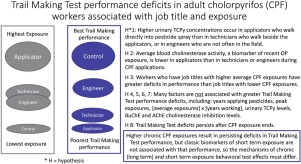当前位置:
X-MOL 学术
›
Neurotoxicology
›
论文详情
Our official English website, www.x-mol.net, welcomes your feedback! (Note: you will need to create a separate account there.)
Magnitude of behavioral deficits varies with job-related chlorpyrifos exposure levels among Egyptian pesticide workers.
NeuroToxicology ( IF 3.4 ) Pub Date : 2020-01-30 , DOI: 10.1016/j.neuro.2020.01.012 W Kent Anger 1 , Fayssal M Farahat 2 , Pamela J Lein 3 , Michael R Lasarev 1 , James R Olson 4 , Taghreed M Farahat 5 , Diane S Rohlman 6
NeuroToxicology ( IF 3.4 ) Pub Date : 2020-01-30 , DOI: 10.1016/j.neuro.2020.01.012 W Kent Anger 1 , Fayssal M Farahat 2 , Pamela J Lein 3 , Michael R Lasarev 1 , James R Olson 4 , Taghreed M Farahat 5 , Diane S Rohlman 6
Affiliation

|
Chronic occupational exposure to organophosphorus pesticides (OPs) is consistently associated with deficits on behavioral tests when compared to unexposed comparison groups. However, a dose-response relationship has yet to be established, leading some to doubt an association between occupational OP exposure and behavioral deficits. Pesticide application teams in Egypt who are primarily exposed to one OP, chlorpyrifos (CPF), were recruited into a field assessment. Trail Making A and the more challenging Trail Making B tests were administered to 54 engineers (who supervise the pesticide application process, usually from the side of the field), 59 technicians (who guide the pesticide applicators in the field), 31 applicators (who mix and apply pesticides using knapsack sprayers), and 150 controls (who did not work in the fields) at two different times during the OP application season as well as immediately after applications had ended and 1.5 months later. All participants were males since only males work on pesticide application teams in Egypt. Urinary levels of 3,5,6-trichloro-2-pyridinol (TCPy), a specific metabolite of CPF, confirmed the pattern of lower to higher CPF exposures from engineers to technicians to applicators, and these were all greater than urinary metabolite levels in controls. A consistent relationship between job title and performance speed on the behavioral task was observed: Controls had the best (fastest) performance on Trail Making A and B tests throughout the application season, and applicators had significantly slower performance than engineers on Trail Making A (p = 0.015) and B (p = 0.003). However, individual urinary TCPy, blood acetylcholinesterase (AChE) and butyrylcholinesterase (BuChE) levels did not predict individual performance. This study identifies a dose-related effect based on job title, which serves as a surrogate for chronic exposure in that differing job titles exhibit varying group exposure levels. The results establish that chronic occupational exposure to chlorpyrifos is neurotoxic and suggest that the classic biomarkers of recent CPF exposure are not predictive of chronic exposure effects.
中文翻译:

行为缺陷的严重程度随埃及农药工人中与工作有关的毒死exposure接触水平而异。
与未暴露的对照组相比,长期职业性接触有机磷农药(OPs)与行为测试不足始终相关。然而,剂量-反应关系尚未建立,导致一些人怀疑职业性OP暴露与行为缺陷之间的关联。招募了埃及的农药施用小组,他们主要接触一种毒死rif(CPF)。分别对54位工程师(通常从现场对农药的施用过程进行监督),59位技术人员(在现场指导农药施药者),31位施药者(其中包括使用背负式喷雾器混合并施用农药),在OP申请季节的两个不同时间,以及在申请结束后立即和1.5个月后,分别提供了150个控件(不在现场工作的控件)。所有参与者均为男性,因为只有男性在埃及的农药施用小组工作。CPF的特定代谢产物3,5,6-三氯-2-吡啶醇(TCPy)的尿液水平证实了从工程师到技术人员再到涂抹者的CPF暴露水平从低到高的模式,并且都高于CPF的尿代谢物水平。控制。在行为任务上,职称与绩效速度之间存在一致的关系:在整个应用季节,控件在Trail Making A和B测试中具有最佳(最快)性能,并且与在Trail Making A上的工程师相比,涂药器的性能明显慢(p = 0.015)和B(p = 0.003)。但是,个体尿液TCPy,血液乙酰胆碱酯酶(AChE)和丁酰胆碱酯酶(BuChE)水平不能预测个体表现。这项研究确定了基于职称的剂量相关效应,这是慢性暴露的替代指标,因为不同的职称表现出不同的群体暴露水平。结果表明,毒死chronic的长期职业暴露具有神经毒性,并表明近期CPF暴露的经典生物标志物不能预测慢性暴露影响。
更新日期:2020-01-31
中文翻译:

行为缺陷的严重程度随埃及农药工人中与工作有关的毒死exposure接触水平而异。
与未暴露的对照组相比,长期职业性接触有机磷农药(OPs)与行为测试不足始终相关。然而,剂量-反应关系尚未建立,导致一些人怀疑职业性OP暴露与行为缺陷之间的关联。招募了埃及的农药施用小组,他们主要接触一种毒死rif(CPF)。分别对54位工程师(通常从现场对农药的施用过程进行监督),59位技术人员(在现场指导农药施药者),31位施药者(其中包括使用背负式喷雾器混合并施用农药),在OP申请季节的两个不同时间,以及在申请结束后立即和1.5个月后,分别提供了150个控件(不在现场工作的控件)。所有参与者均为男性,因为只有男性在埃及的农药施用小组工作。CPF的特定代谢产物3,5,6-三氯-2-吡啶醇(TCPy)的尿液水平证实了从工程师到技术人员再到涂抹者的CPF暴露水平从低到高的模式,并且都高于CPF的尿代谢物水平。控制。在行为任务上,职称与绩效速度之间存在一致的关系:在整个应用季节,控件在Trail Making A和B测试中具有最佳(最快)性能,并且与在Trail Making A上的工程师相比,涂药器的性能明显慢(p = 0.015)和B(p = 0.003)。但是,个体尿液TCPy,血液乙酰胆碱酯酶(AChE)和丁酰胆碱酯酶(BuChE)水平不能预测个体表现。这项研究确定了基于职称的剂量相关效应,这是慢性暴露的替代指标,因为不同的职称表现出不同的群体暴露水平。结果表明,毒死chronic的长期职业暴露具有神经毒性,并表明近期CPF暴露的经典生物标志物不能预测慢性暴露影响。



























 京公网安备 11010802027423号
京公网安备 11010802027423号